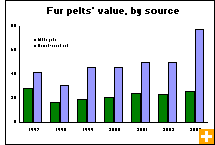Common menu bar links
The fur industry: Changing with the times
Archived Content
Information identified as archived is provided for reference, research or recordkeeping purposes. It is not subject to the Government of Canada Web Standards and has not been altered or updated since it was archived. Please contact us to request a format other than those available.
A thriving fur industry was one of the initial pulls that brought many of the first European settlers to Canada. Fur was one of Canada’s first major industries, and it drove the economy for many years. Although no longer an economic leader, the fur industry remains important, and is a source of income for more than 65,000 Canadians.
From 1970 to 1987, the fur industry was stable, with average sales of 4.6 million pelts a year. Over the next three years, however, as animal rights activists raised concerns about the fur industry’s practices, pelt production fell 62% to a low of 1.7 million in 1990.
In the years following the collapse, the production and value of pelts fluctuated as the industry tried to find new markets. Since 1998, the total sales for fur pelts have more than doubled, reaching $103.6 million in 2003. Total pelt production, however, increased only slightly during this period. The big difference was the increase in the average value per fur pelt, which almost doubled to $43.49 in 2003 from $22.91 in 1998.
 Fur
trappers have historically been the major suppliers to the fur industry.
Over the past few years, however, ranchers raising mink and fox have
become the largest producers of fur pelts. The value of ranch-raised
pelts has more than doubled since 1998, reaching $77.5 million
in 2003. Nova Scotia has emerged as Canada’s leader in ranch-raised
pelts, producing more than half of the total sales of ranched fur
in 2003. Quebec and Ontario remain the centres for fur trapping,
together accounting for more than one-third of the total wildlife
pelts produced in 2003.
Fur
trappers have historically been the major suppliers to the fur industry.
Over the past few years, however, ranchers raising mink and fox have
become the largest producers of fur pelts. The value of ranch-raised
pelts has more than doubled since 1998, reaching $77.5 million
in 2003. Nova Scotia has emerged as Canada’s leader in ranch-raised
pelts, producing more than half of the total sales of ranched fur
in 2003. Quebec and Ontario remain the centres for fur trapping,
together accounting for more than one-third of the total wildlife
pelts produced in 2003.


